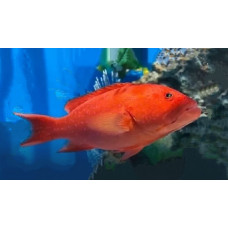Latin name
Variola albimarginata
Other name
White-edge coronation trout, lyretail grouper, lyretail trout, white-edged lyretail-cod or white-fringed moontail-bass.
Identification
This species was first officially described by J. de Baissac in 1953, and the location of the species was given as Mauritius.
The white-edged lyretail has an elongated body with a head length greater than its body depth, the standard body length being 2.8-3.5 times its depth. The gill cover is rounded, with fine serrations along the edge, and the lower edge is fleshy. There are three flat spines on the gill cover, the upper edge of which is straight.
Features of fish fins
Dorsal spines (total): 9; Dorsal soft rays (total): 14; Anal spines: 3; Anal soft rays: 8.
The dorsal fin contains 9 spines and 14 soft rays, while the anal fin contains 3 spines and 8 soft rays. The caudal fin is crescent shaped with elongated upper and lower lobes and is about twice as long as the middle rays of the fin.
Fish colouring
The overall coloration of this bass is reddish with blue spots. The caudal fin has pale upper and lower edges, and the central rays of the caudal fin have white tips that form a thin white line along the edge. Occasionally there are faint pale saddles on the back. It also has yellow wavy lines on the body and reddish patches on the head. The dorsal, anal and caudal fins are covered with red to purple spots.
Distribution
Widespread in the Indo-Pacific region. It extends from the East African coast between Kenya and Mozambique, including Zanzibar and Mafia Island, across the Indian Ocean to the Seychelles, southwestern India and Sri Lanka, and into the Pacific Ocean, north to the Ryukyu Islands in southern Japan, east to Samoa and the Cook Islands, and south to Australia. In Australia, it occurs from Scott Reef in Western Australia, Ashmore Reef in the Timor Sea to the Capricorn Group in the southern Great Barrier Reef of Queensland.
Habitat
Marine tropical, reef associated species. Depths from 4 to 200 meters.
Size
The maximum recorded total length of this species is 65 centimeters (26 inches).
Behavior
A rare species found either singly or in small groups on coastal reefs. Juveniles are found near shore on algae and soft coral reefs where they usually swim quite high in the water column like perches.
Food and feeding habits
The white-edged lyretail feeds mainly on fish.
Reproduction
Do not form spawning aggregations. Females reach sexual maturity at a standard length of 32 centimeters (13 inches).
Fishing
Due to its small size and rarity, this species is of little interest to fisheries. It is caught with lines, traps and spears.
Relationship with a person
Harmless. The flesh of this fish has an excellent taste.
| Classification | |
| Phylum | Chordata |
| Class | Actinopterygii |
| Squad | Perciformes |
| Family | Serranidae |
| Genus | Variola |
| Species | V. albimarginata |
| Features | |
| Conservation status | Least Concern |
| Habitat | Pelagic |
| Life span, years | No information |
| Maximum body weight, kg | No information |
| Maximum length, cm | 65 |
| Sailing speed, m/s | No information |
| Threat to people | Edible |
| Way of eating | Predator |
White-edged lyretail
Tags: white edged lyretail

